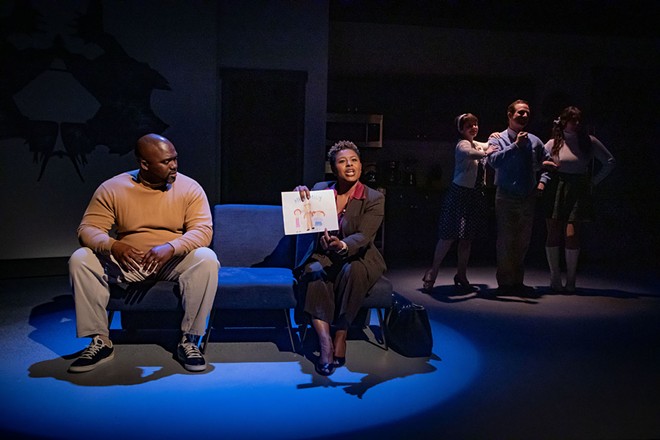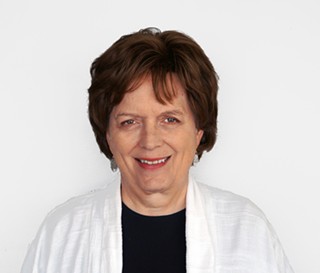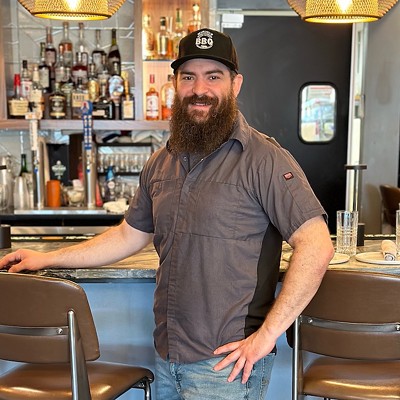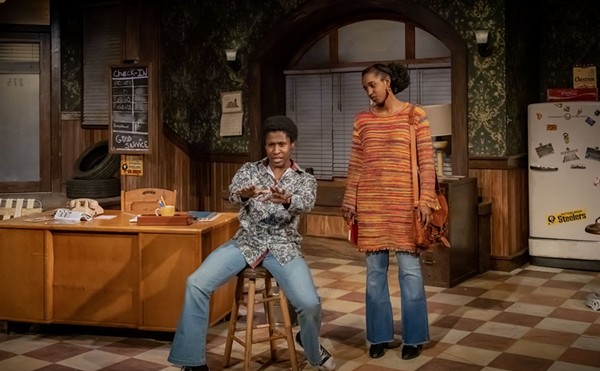"What We Look Like," Now at Dobama, Has Too Much to Say
There are laughs and standout scenes in this play about a Black family moving into a white neighborhood, but an overstuffed script and runtime drag it down
By Christine Howey on Mon, Apr 24, 2023 at 1:10 pm
[
{
"name": "Ad - NativeInline - Injected",
"component": "38482495",
"insertPoint": "3",
"requiredCountToDisplay": "5"
},{
"name": "Real 1 Player (r2) - Inline",
"component": "38482494",
"insertPoint": "2/3",
"requiredCountToDisplay": "9"
}
]
Did you ever wonder what you look like to your neighbors? One day you're super snazzy, dressed up and knocking 'em dead at work or an event. And the next morning there you are, frizzy-haired in a flannel robe and floppy slippers, watching your dog take a crap on the tree lawn. We always present different images of ourselves to others. And if you're the first Black family moving into a lily-white suburban neighborhood, the angst of how you're being perceived is multiplied tenfold.
Such is the case in What We Look Like by B.J. Tindal, now receiving its world premiere at Dobama Theatre. Tindal, a recent grad of Oberlin College, displays a deft touch with humor that ranges from loud and silly to slyly clever. But the good parts of his script are frequently overwhelmed by repetition and too many scenes that only add to the production's King Lear-ish run time (approaching three hours).
Speaking of Shakespeare, he once noted that the soul of wit is brevity. And there are many isolated bursts of that kind of wit throughout this piece as we meet Jean and Brian Hodges. They are the married Black couple who move in with their three kids Angie, Edmund and Tommy—and we immediately get the idea there are problems afoot.
Jean and Brian are seeing a marriage counselor, because their youngest child Tommy recently came home with a portrait he drew of his family, an imaginary white family, and his parents are thrown for a loop. That white family, called the Hockenberrys, appear in person on stage and turn out to be a farcically dim-witted trio, two parents and child, who appear now and then in the Hodges' kitchen but are invisible to the Hodges.
Although we never meet Tommy (he is always either at school or in his room), we get plenty of information about his two siblings: Teenagers Angie (Diwe Augustin-Glave) and Edmond (an amusing but at times shrill Aamar-Malik Culbreth). They are both bright, with Edmond being the "good son" who nails his grades and never causes trouble. Angie, who may be even smarter than Edmund, wields snark like a weapon as she begins to explore her gender identity and attraction to girls, and Augustin-Glave nails the part.
Soon, the Hodges are introduced to their real-life next-door neighbors, the Beckons family, which includes mom Martha (Katie Booze-Mooney), dad Steven (Andrew Gorell) and their teen daughter Zoey (Alexa Fatheringham). Those three actors also do double-duty as the hokey Hockenberrys.
At this point, it's clear that playwright Tindal has launched many balls in the air, and it's up to him and director Darius J. Stubbs to juggle them to deliver the jokes while also exploring some serious subtexts at hand. In this task, they are only partially successful.
When WWLL works well, it's damn funny. Tindal succeeds in creating distinctive characters for the Hodges and Beckons clans, and their dialogue often sparks repeated laughs. As Jean, Katrice Headd anchors the proceedings with professional aplomb, dueling with her loving but ever-confused husband Brian (Rob Grant III) while trying to manage the white folks who appear in her kitchen one day asking to heat up their Hot Pockets in the Hodges' microwave. She and Brian are also trying to encourage brainiac Edmond to get friendly with a young Black girl they know. But Ed is gaga for Zoey who, in turn, is drawn to the edgy charms of Angie.
These racial, gender and sexual orientation switches come to a head in the Act Two climactic scene, staged as a "last supper," when all is revealed and the rubber of Tindal's creation finally hits the road. It's one dandy scene.
Trouble is, the play then continues for another half hour or so, dragging failed subplots—such as the ghostly Hockenberrys and a half-hearted swing at the Beckons' marital difficulties—along with it. Director Stubbs should be lauded for getting effective and evocative performances from his cast. But Tindal's script is over-written in many places and Stubbs doesn't help smooth out that tangle. At times, he has spotlights switch on and off rapidly from one speaker to another, an unnecessary attempt to focus attention that might only succeed in triggering slow-motion strobe headaches in some audience members.
Also, the scenic design by the usually excellent Cameron Michalak is boring when it's not cumbersome. It features a long upstage wall punctuated by a kitchen counter and fridge at one end, and a large wall image of a Rorschach inkblot at the other. That section of the wall is a separate unit and is frequently hauled out and turned around to serve as different bedrooms, while loose chairs are dragged here and there to represent this and that. The result looks like a half-finished rehearsal set.
Along the way, Tindal's script has some fun with the "magic" of double negatives, the ungrammatical art of saying something positive with a negative gloss. So, in that spirit it would be accurate to say that What We Look Like is not a bad play. But it is a play that doesn't realize how good it would be if it were edited with vigor and staged with more verve.
What We Look Like
Through May 24 at Dobama Theatre, 2340 Lee Road, Cleveland Heights, 216-932-3396, dobama.org.
Such is the case in What We Look Like by B.J. Tindal, now receiving its world premiere at Dobama Theatre. Tindal, a recent grad of Oberlin College, displays a deft touch with humor that ranges from loud and silly to slyly clever. But the good parts of his script are frequently overwhelmed by repetition and too many scenes that only add to the production's King Lear-ish run time (approaching three hours).
Speaking of Shakespeare, he once noted that the soul of wit is brevity. And there are many isolated bursts of that kind of wit throughout this piece as we meet Jean and Brian Hodges. They are the married Black couple who move in with their three kids Angie, Edmund and Tommy—and we immediately get the idea there are problems afoot.
Jean and Brian are seeing a marriage counselor, because their youngest child Tommy recently came home with a portrait he drew of his family, an imaginary white family, and his parents are thrown for a loop. That white family, called the Hockenberrys, appear in person on stage and turn out to be a farcically dim-witted trio, two parents and child, who appear now and then in the Hodges' kitchen but are invisible to the Hodges.
Although we never meet Tommy (he is always either at school or in his room), we get plenty of information about his two siblings: Teenagers Angie (Diwe Augustin-Glave) and Edmond (an amusing but at times shrill Aamar-Malik Culbreth). They are both bright, with Edmond being the "good son" who nails his grades and never causes trouble. Angie, who may be even smarter than Edmund, wields snark like a weapon as she begins to explore her gender identity and attraction to girls, and Augustin-Glave nails the part.
Soon, the Hodges are introduced to their real-life next-door neighbors, the Beckons family, which includes mom Martha (Katie Booze-Mooney), dad Steven (Andrew Gorell) and their teen daughter Zoey (Alexa Fatheringham). Those three actors also do double-duty as the hokey Hockenberrys.
At this point, it's clear that playwright Tindal has launched many balls in the air, and it's up to him and director Darius J. Stubbs to juggle them to deliver the jokes while also exploring some serious subtexts at hand. In this task, they are only partially successful.
When WWLL works well, it's damn funny. Tindal succeeds in creating distinctive characters for the Hodges and Beckons clans, and their dialogue often sparks repeated laughs. As Jean, Katrice Headd anchors the proceedings with professional aplomb, dueling with her loving but ever-confused husband Brian (Rob Grant III) while trying to manage the white folks who appear in her kitchen one day asking to heat up their Hot Pockets in the Hodges' microwave. She and Brian are also trying to encourage brainiac Edmond to get friendly with a young Black girl they know. But Ed is gaga for Zoey who, in turn, is drawn to the edgy charms of Angie.
These racial, gender and sexual orientation switches come to a head in the Act Two climactic scene, staged as a "last supper," when all is revealed and the rubber of Tindal's creation finally hits the road. It's one dandy scene.
Trouble is, the play then continues for another half hour or so, dragging failed subplots—such as the ghostly Hockenberrys and a half-hearted swing at the Beckons' marital difficulties—along with it. Director Stubbs should be lauded for getting effective and evocative performances from his cast. But Tindal's script is over-written in many places and Stubbs doesn't help smooth out that tangle. At times, he has spotlights switch on and off rapidly from one speaker to another, an unnecessary attempt to focus attention that might only succeed in triggering slow-motion strobe headaches in some audience members.
Also, the scenic design by the usually excellent Cameron Michalak is boring when it's not cumbersome. It features a long upstage wall punctuated by a kitchen counter and fridge at one end, and a large wall image of a Rorschach inkblot at the other. That section of the wall is a separate unit and is frequently hauled out and turned around to serve as different bedrooms, while loose chairs are dragged here and there to represent this and that. The result looks like a half-finished rehearsal set.
Along the way, Tindal's script has some fun with the "magic" of double negatives, the ungrammatical art of saying something positive with a negative gloss. So, in that spirit it would be accurate to say that What We Look Like is not a bad play. But it is a play that doesn't realize how good it would be if it were edited with vigor and staged with more verve.
What We Look Like
Through May 24 at Dobama Theatre, 2340 Lee Road, Cleveland Heights, 216-932-3396, dobama.org.
Tags:
SCENE Supporters make it possible to tell the Cleveland stories you won’t find elsewhere.
Become a supporter today.
About The Author
Christine Howey
Christine Howey has been reviewing theater since 1997, first at Cleveland Free Times and then for other publications including City Pages in Minneapolis, MN and The Plain Dealer. Her blog, Rave and Pan, also features her play reviews. Christine is a former stage actor and director, primarily at Dobama Theatre...
Scroll to read more Arts Stories & Interviews articles
Newsletters
Join Cleveland Scene Newsletters
Subscribe now to get the latest news delivered right to your inbox.













